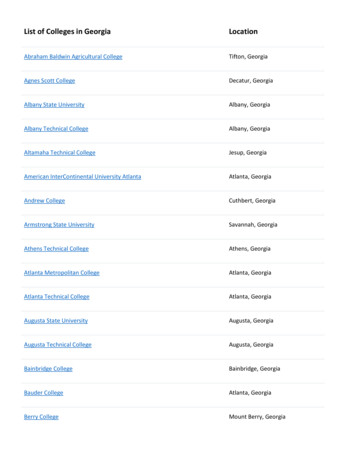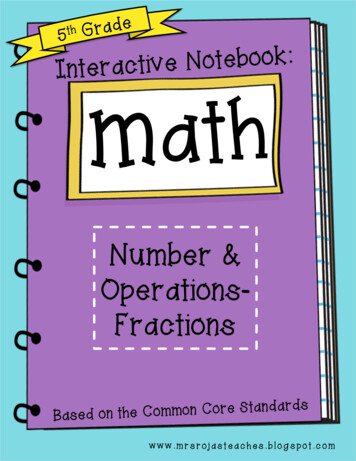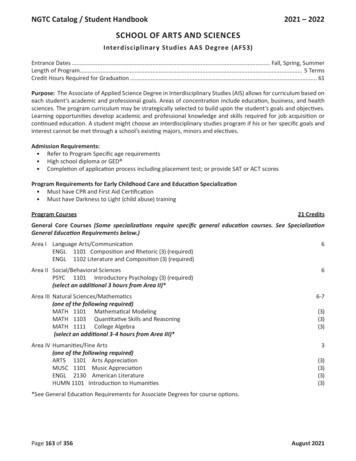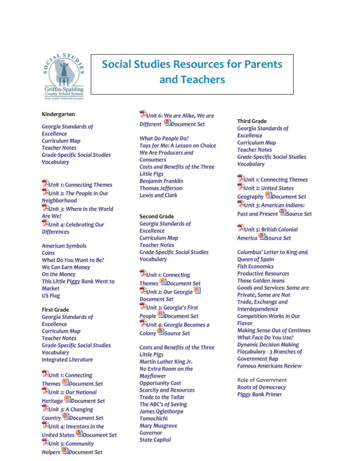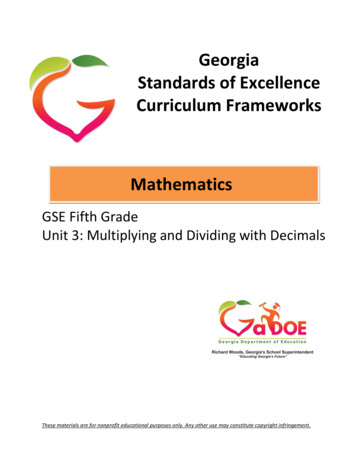
Transcription
GeorgiaStandards of ExcellenceCurriculum FrameworksMathematicsGSE Fifth GradeUnit 3: Multiplying and Dividing with DecimalsThese materials are for nonprofit educational purposes only. Any other use may constitute copyright infringement.
Georgia Department of EducationGeorgia Standards of Excellence FrameworkGSE Multiplying and Dividing with Decimals Unit 3Unit 3: Multiplying and Dividing with DecimalsTABLE OF CONTENTSOverview .3Standards for Mathematical Practice .4Standards for Mathematical Content .5Big Ideas .5Essential Questions .5Concepts and Skills to Maintain .6Strategies for Teaching and Learning .7Selected Terms and Symbols .7Tasks .10Intervention Table .12 Power-ful Exponents .13What Comes Next? .19Patterns-R-Us .26Base Ten Activity .30Missing Numbers .37Multiplication Teasers .39How Much Money? .43Place the Point.47Super Slugger Award .50Number Puzzles .54What’s My Rule? .59Do You See an Error? .62Road Trip .66Multiplying and Dividing Decimals . 70Penny Cube .71Teacher for a Day.80Bargain Shopping.84Hanging by a Hair .90Field Trip .96IF YOU HAVE NOT READ THE 5th GRADE CURRICULUM OVERVIEW IN ITS ENTIRETY PRIORTO USE OF THIS UNIT, PLEASE STOP AND CLICK Return to the use of this unit once you’ve completed reading the Curriculum Overview. Thank you.Mathematics GSE Fifth Grade Unit Three Unit 3: Multiplying and Dividing DecimalsRichard Woods, State School SuperintendentJuly 2021 Page 2 of 100All Rights Reserved
Georgia Department of EducationGeorgia Standards of Excellence FrameworkGSE Multiplying and Dividing with Decimals Unit 3OVERVIEWPerform operations with multi-digit whole numbers and with decimals to the hundredths.General methods used for computing products of whole numbers extend to products ofdecimals. Because the expectations for decimals are limited to thousandths and expectations forfactors are limited to hundredths at this grade level, students will multiply tenths with tenths andtenths with hundredths, but they need not multiply hundredths with hundredths. Before studentsconsider decimal multiplication more generally, they can study the effect of multiplying by 0.1and by 0.01 to explain why the product is ten or a hundred times as small as the multiplicand(moves one or two places to the right). They can then extend their reasoning to multipliers thatare single-digit multiples of 0.1 and 0.01 (e.g., 0.2 and 0.02, etc.).There are several lines of reasoning students can use to explain the placement of thedecimal point in other products of decimals. Students can think about the product of the smallestbase-ten units of each factor. For example, a tenth times a tenth is a hundredth, so 3.2 x 7.1 willhave an entry in the hundredths place. Note, however, that students might place the decimal pointincorrectly for 3.2 x 8.5 unless they take into account the 0 in the ones place in the product of 32x 85. (Or they can think of 0.2 x 0.5 as 10 hundredths.) They can also think of decimals asfractions or as whole numbers divided by 10 or 100. When they place the decimal point in theproduct, they have to divide by a 10 from each factor or 100 from one factor. For example, to seethat 0.6 x 0.8 0.48, students can use fractions: 6/10 x 8/10 48/100. Students can also reasonthat when they carry out the multiplication without the decimal point, they have multiplied eachdecimal factor by 10 or 100, so they will need to divide by those numbers in the end to get thecorrect answer. Also, students can use reasoning about the sizes of numbers to determine theplacement of the decimal point. For example, 3.2 x 8.5 should be close to 3 x 9, so 27.2 is a morereasonable product for 3.2 x 8.5 than 2.72 or 272. This estimation based method is not reliable inall cases, however, especially in cases students will encounter in later grades. For example, it isnot easy to decide where to place the decimal point in 0.023 x 0.0045 based on estimation.Students can summarize the results of their reasoning such as those above as specific numericalpatterns and then as one general overall pattern such as “the number of decimal places in theproduct is the sum of the number of decimal places in each factor.”General methods used for computing quotients of whole numbers extend to decimals withthe additional issue of placing the decimal point in the quotient. As with decimal multiplication,students can first examine the cases of dividing by 0.1 and 0.01 to see that the quotient becomes10 times or 100 times as large as the dividend. For example, students can view 7 0.1 asasking how many tenths are in 7. Because it takes 10 tenths to make 1, it takes 7 times as manytenths to make 7, so 7 0.1 7 x 10 70. Or students could note that 7 is 70 tenths, so askinghow many tenths are in 7 is the same as asking how many tenths are in 70 tenths, which is 70. Inother words, 7 0.1 is the same as 70 1. So, dividing by 0.1 moves the number 7 one place tothe left, the quotient is ten times as big as the dividend. As with decimal multiplication, studentscan then proceed to more general cases. For example, to calculate 7 0.2, students can reasonthat 0.2 is 2 tenths and 7 is 70 tenths, so asking how many 2 tenths are in 7 is the same as askinghow many 2 tenths are in 70 tenths. In other words, 7 0.2 is the same as 70 2; multiplyingboth the 7 and the 0.2 by 10 results in the same quotient. Or students could calculate 7 0.2 byviewing the 0.2 as 2 x 0.1, so they can first divide 7 by 2, which is 3.5, and then divide that resultby 0.1, which makes 3.5 ten times as large, namely 35. Dividing by a decimal less than 1 resultsin a quotient larger than the dividend and moves the digits of the dividend one place to the left.Students can summarize the results of their reasoning as specific numerical patterns then as oneMathematics GSE Fifth Grade Unit Three Unit 3: Multiplying and Dividing DecimalsRichard Woods, State School SuperintendentJuly 2021 Page 3 of 100All Rights Reserved
Georgia Department of EducationGeorgia Standards of Excellence FrameworkGSE Multiplying and Dividing with Decimals Unit 3general overall pattern.Mathematically proficient students communicate precisely by engaging in discussionabout their reasoning using appropriate mathematical language. The terms students should learnto use with increasing precision with these clusters are: place value, patterns,multiplication/multiply, division/divide, decimal, decimal point, tenths, hundredths,products, quotients, dividends, rectangular arrays, area models, addition/add,subtraction/subtract, (properties)-rules about how numbers work, reasoning.These tasks are not intended to be the sole source of instruction. They are representative ofthe kinds of experiences students will need in order to master the content, as well as mathematicalpractices that lead to conceptual understanding. Teachers should NOT do every task in the unit; theyshould choose the tasks that fit their students’ needs.*For more detailed information about unpacking the content standards, unpacking a task, mathroutines and rituals, maintenance activities and more, please refer to the Grade Level Overview.STANDARDS FOR MATHEMATICAL PRACTICEThis section provides examples of learning experiences for this unit that support the development ofthe proficiencies described in the Standards for Mathematical Practice. These proficienciescorrespond to those developed through the Literacy Standards. The statements provided offer a fewexamples of connections between the Standards for Mathematical Practice and the Content Standardsof this unit. The list is not exhaustive and will hopefully prompt further reflection and discussion.1. Make sense of problems and persevere in solving them. Students solve problems by applyingand extending their understanding of multiplication and division to decimals. Students seek themeaning of a problem and look for efficient ways to solve it. They determine where to placethe decimal point in calculations.2. Reason abstractly and quantitatively. Students demonstrate abstract reasoning to connectdecimal quantities to fractions, and to compare relative values of decimal numbers. Studentsround decimal numbers using place value concepts.3. Construct viable arguments and critique the reasoning of others. Students constructarguments using concrete referents, such as objects, pictures, and drawings. They explaincalculations and placement of the decimal point, based upon models and rules that generatepatterns. They explain their thinking to others and respond to others’ thinking.4. Model with mathematics. Students use base ten blocks, drawings, number lines, and equationsto represent decimal place value, multiplication and division. They determine which modelsare most efficient for solving problems.5. Use appropriate tools strategically. Students select and use tools such as graph or grid paper,base ten blocks, and number lines to accurately solve multiplication and division problems withdecimals.Mathematics GSE Fifth Grade Unit Three Unit 3: Multiplying and Dividing DecimalsRichard Woods, State School SuperintendentJuly 2021 Page 4 of 100All Rights Reserved
Georgia Department of EducationGeorgia Standards of Excellence FrameworkGSE Multiplying and Dividing with Decimals Unit 36. Attend to precision. Students use clear and precise language, (math talk) in their discussionswith others and in their own reasoning. Students use appropriate terminology when referringto decimal place value and use decimal points correctly.7. Look for and make use of structure. Students use properties of operations as strategies tomultiply and divide with decimals. Students utilize patterns in place value and powers of tento correctly place the decimal point.8. Look for and express regularity in repeated reasoning. Students use repeated reasoning tounderstand algorithms and make generalizations about patterns. Students connect place valueand properties of operations to fluently multiply and divide decimals.***Mathematical Practices 1 and 6 should be evident in EVERY lesson***STANDARDS FOR MATHEMATICAL CONTENTUnderstand the place value system.MGSE5.NBT.2 Explain patterns in the number of zeros of the product when multiplying anumber by powers of 10, and explain patterns in the placement of the decimal point when adecimal is multiplied or divided by a power of 10. Use whole-number exponents to denotepowers of 10.Perform operations with multi-digit whole numbers and with decimals to the hundredths.MGSE5.NBT.7 Add, subtract, multiply, and divide decimals to hundredths, using concretemodels or drawings and strategies based on place value, properties of operations, and/or therelationship between addition and subtraction; relate the strategy to a written method andexplain the reasoning used.BIG IDEAS Students will understand that the placement of the decimal is determined by multiplying ordividing a number by 10 or a multiple of 10.Students will understand that multiplication and division are inverse operations of each other.Students will understand that rules for multiplication and division of whole numbers alsoapply to decimals.ESSENTIAL QUESTIONS How can we use exponents to represent powers of 10?How does multiplying or dividing by a power of ten affect the product?How can we use models to help us multiply and divide decimals?How do the rules of multiplying whole numbers relate to multiplying decimals?How are multiplication and division related?How are factors and multiples related to multiplication and division?Mathematics GSE Fifth Grade Unit Three Unit 3: Multiplying and Dividing DecimalsRichard Woods, State School SuperintendentJuly 2021 Page 5 of 100All Rights Reserved
Georgia Department of EducationGeorgia Standards of Excellence Framework GSE Multiplying and Dividing with Decimals Unit 3What are some patterns that occur when multiplying and dividing by decimals?How can we efficiently solve multiplication and division problems with decimals?What strategies are effective for finding a missing factor or divisor?How can we check for errors in multiplication or division of decimals?CONCEPTS/SKILLS TO MAINTAINThis standard requires students to extend the models and strategies they developed for wholenumbers in grades 1-4 to decimal values. Before students are asked to give exact answers, theyshould estimate answers based on their understanding of operations and the value of the numbers.It is expected that students will have prior knowledge/experience related to the concepts and skillsidentified below. It may be necessary to pre-assess in order to determine if time needs to be spent onconceptual activities that help students develop a deeper understanding of these ideas. Number sense Whole number computationFluency: Procedural fluency is defined as skill in carrying out procedures flexibly, accurately, efficiently,and appropriately. Fluent problem solving does not necessarily mean solving problems within a certaintime limit, though there are reasonable limits on how long computation should take. Fluency is based on adeep understanding of quantity and number.Deep Understanding: Teachers teach more than simply “how to get the answer” and instead supportstudents’ ability to access concepts from a number of perspectives. Therefore, students are able to seemath as more than a set of mnemonics or discrete procedures. Students demonstrate deep conceptualunderstanding of foundational mathematics concepts by applying them to new situations, as well aswriting and speaking about their understanding.Memorization: The rapid recall of arithmetic facts or mathematical procedures. Memorization is oftenconfused with fluency and automaticity. Fluency implies a much richer kind of mathematical knowledgeand experience.Number Sense: Students consider the context of a problem, look at the numbers in a problem, make adecision about which strategy would be most efficient in each particular problem. Number sense is not adeep understanding of a single strategy, but rather the ability to think flexibly between a variety ofstrategies in context.Fluent students: flexibly use a combination of deep understanding, number sense, and memorization.are fluent in the necessary baseline functions in mathematics so that they are able to spend theirthinking and processing time unpacking problems and making meaning from them.are able to articulate their reasoning.find solutions through a number of different paths.Mathematics GSE Fifth Grade Unit Three Unit 3: Multiplying and Dividing DecimalsRichard Woods, State School SuperintendentJuly 2021 Page 6 of 100All Rights Reserved
Georgia Department of EducationGeorgia Standards of Excellence FrameworkGSE Multiplying and Dividing with Decimals Unit 3For more about fluency, see: FluencyWithoutFear-2015.pdf and: EGIES FOR TEACHING AND LEARNINGAs students developed efficient strategies to do whole number operations, they should also developefficient strategies with decimal operations.Students should learn to estimate decimal computations before they compute with pencil and paper.The focus on estimation should be on the meaning of the numbers and the operations, not on howmany decimal places are involved. For example, to estimate the product of 32.84 4.6, the estimatewould be more than 120, closer to 150. Students should consider that 32.84 is closer to 30 and 4.6 iscloser to 5. The product of 30 and 5 is 150. Therefore, the product of 32.84 4.6 should be close to150.Have students use estimation to find the product by using exactly the same digits in one of the factorswith the decimal point in a different position each time. For example, have students estimate theproduct of 275 3.8; 27.5 3.8 and 2.75 3.8, and discuss why the estimates should or should notbe the same.In addition to strategies specific to content standards, students should also practice the followingthroughout the unit: Students should be actively engaged by developing their own understanding.Mathematics should be represented in as many ways as possible by using graphs, tables,pictures, symbols, and words. Appropriate manipulatives and technology should be used to enhance student learning. Students should be given opportunities to revise their work based on teacher feedback, peerfeedback, and metacognition which includes self-assessment and reflection. Students need to write in mathematics class to explain their thinking, talk about how theyperceive topics, and justify their work to others.Teachers need to provide instructional experiences so that students progress from theconcrete level, to the pictorial level, then to the abstract level when learning mathematicalconcepts.SELECTED TERMS AND SYMBOLSThe following terms and symbols are often misunderstood. These concepts are not an inclusive listand should not be taught in isolation. However, due to evidence of frequent difficulty andmisunderstanding associated with these concepts, instructors should pay particular attention to themand how their students are able to explain and apply them.The terms below are for teacher reference only and are not to be memorized by students.Teachers should first present these concepts to students with models and real life examples. Studentsshould understand the concepts involved and be able to recognize and/or use them with words,models, pictures, or numbers.Mathematics GSE Fifth Grade Unit Three Unit 3: Multiplying and Dividing DecimalsRichard Woods, State School SuperintendentJuly 2021 Page 7 of 100All Rights Reserved
Georgia Department of EducationGeorgia Standards of Excellence FrameworkGSE Multiplying and Dividing with Decimals Unit 3 arrayassociative property of multiplicationcommutative property of multiplicationdistributive ed thousandshundredshundredthsidentity property of multiplicationmeasurement division (or repeated subtraction)millionsmultiplemultiplieronespartial productspartition/partitive division (or fair-sharing)place valuepower of tenproductquotientremainderten thousandstenstenthsthousandsMathematics GSE Fifth Grade Unit Three Unit 3: Multiplying and Dividing DecimalsRichard Woods, State School SuperintendentJuly 2021 Page 8 of 100All Rights Reserved
Georgia Department of EducationGeorgia Standards of Excellence FrameworkGSE Multiplying and Dividing with Decimals Unit 3TASKSScaffolding TaskConstructing TaskPractice TaskPerformance TaskCulminating TaskTasks that build up to the learning task.Constructing understanding through deep/rich contextualized problem solvingtasks.Tasks that provide students opportunities to practice skills and concepts.Tasks which may be a formative or summative assessment that checks forstudent understanding/misunderstanding and or progress toward thestandard/learning goals at different points during a unit of instruction.Designed to require students to use several concepts learned during the unit toanswer a new or unique situation. Allows students to give evidence of theirown understanding toward the mastery of the standard and requires them toextend their chain of mathematical reasoning.Intervention TableThe Intervention Table provides links to interventions specific to thisunit. The interventions support students and teachers in fillingfoundational gaps revealed as students work through the unit. All listedinterventions are from New Zealand’s Numeracy Project.Formative AssessmentLesson (FAL)Lessons that support teachers in formative assessment which both reveal anddevelop students’ understanding of key mathematical ideas and applications.These lessons enable teachers and students to monitor in more detail theirprogress towards the targets of the standards.Designed to demonstrate how the GSE and Career and Technical Educationknowledge and skills can be integrated. The tasks provide teachers withrealistic applications that combine mathematics and CTE content.A Three-Act Task is a whole-group mathematics task consisting of 3 distinctparts: an engaging and perplexing Act One, an information and solutionseeking Act Two, and a solution discussion and solution revealing Act Three.More information along with guidelines for 3-Act Tasks may be found in theGuide to Three-Act Tasks on georgiastandards.org.CTE Classroom Tasks3-Act TaskMathematics GSE Fifth Grade Unit Three Unit 3: Multiplying and Dividing DecimalsRichard Woods, State School SuperintendentJuly 2021 Page 9 of 100All Rights Reserved
Georgia Department of EducationGeorgia Standards of Excellence FrameworkGSE Multiplying and Dividing with Decimals Unit 3Task DescriptionTask NamePower-ful ExponentsWhat Comes Next?Patterns-R-UsBase Ten ActivityTask Type/Grouping StrategyContent AddressedPractice/Whole group, smallWhole number exponentsgroup or individualConstructing/Whole group, small Multiplying or dividing bygrouppowers of tenScaffolding-Constructing/Small Multiplying or dividing bygrouppowers of ffolding-Constructing/Small Modeling the multiplicationMGSE5.NBT.7group or pairof decimalsMultiplicationTeasersConstructing/Small group orindividualConstructing/Small group orindividualHow Much Money?Constructing/Individual or pairDividing decimalsPlace the PointConstructing/Small group orindividualDividing decimalsSuper SluggerAwardPractice/Individual or pairDividing decimalsNumber PuzzlesPractice/Individual or pairWhat’s My Rule?Practice/Whole group or smallgroupDo You See anError?Practice/Individual or pairRoad TripPractice/Individual or pairMissing NumbersStandard(s)Multiplying decimalsMultiplying decimalsMultiplying & dividingdecimalsMultiplying & dividingdecimalsMultiplying & dividingdecimalsMultiplying & T.7MGSE5.NBT.7MGSE5.NBT.7Mathematics GSE Fifth Grade Unit Three Unit 3: Multiplying and Dividing DecimalsRichard Woods, State School SuperintendentJuly 2021 Page 10 of 100All Rights ReservedExpressing place value withexponentsExploring powers of tenwith base ten blocksIdentifying patterns ofmultiplication and divisionCreating rectangular arraysfor multiplication anddivision with decimalsMissing numbers in decimalmultiplicationMissing factors inmultiplicationDetermining number ofcoins equal to a given valueUsing estimation todetermine the place of thedecimalDetermining baseballaverages in a graphMultiplying and dividingdecimals for number puzzlesDiscovering rules withmultiplication and divisionFinding errors in studentworkDetermining fuel costs
Georgia Department of EducationGeorgia Standards of Excellence FrameworkGSE Multiplying and Dividing with Decimals Unit 3Multiplying andDividing DecimalsFormative Assessment Lesson(FAL)Multiplying & dividingdecimalsMultiply and dividedecimals to solve a problemMultiplying & dividingdecimalsMultiplying & dividingdecimalsPenny CubeLearning TaskTeacher for a DayPerformance/IndividualBargain ShoppingPerformance/IndividualHanging by a HairCulminating TaskMultiply and dividedecimals to solve a problemField TripCulminating/IndividualMultiplying .NBT.2MGSE5.NBT.7MGSE5.NBT.2MGSE5.NBT.7Formative Assessment onmultiplying and dividingdecimalsWondering of a cube fillingup with penniesExplaining how to multiplyand divide decimalsDetermining the best priceof objectsWonderings of how muchhair it would take to holdyour body weightPlanning the most costeffective field tripIf you need further information about this unit visit the GaDOE website and reference the unit /Pages/default.aspxMathematics GSE Fifth Grade Unit Three Unit 3: Multiplying and Dividing DecimalsRichard Woods, State School SuperintendentJuly 2021 Page 11 of 100All Rights Reserved
Georgia Department of EducationGeorgia Standards of Excellence FrameworkGSE Multiplying and Dividing with Decimals Unit 3INTERVENTION TABLEThe Intervention Table below provides links to interventions specific to this unit. The interventions support students and teachers in fillingfoundational gaps revealed as students work through the unit. All listed interventions are from New Zealand’s Numeracy Project.Cluster of StandardsName of InterventionSnapshot of summary or Student I can statement. . .Understand the place valuesystem.MGSE5.NBT.2Sherpa (Tensing)Multiply by powers of 10.Perform operations with multidigit whole numbers and withdecimals to hundredths.MGSE5.NBT.7Estimation in DecimalMultiplication andDivision ProblemsMultiplication ofDecimal FractionsMultiplication withTenthsWhen Big Gets SmallerWhen Small GetsBiggerMaterials MasterEstimate decimal products and quotients by roundingand using benchmark fractions.Reason about the location of decimal point for productsand quotients using visual models.Solve multiplication and division problems by usingplace value.Reason about relative magnitude of decimalmultiplication.Reason about relative magnitude of decimal division.Mathematics GSE Fifth Grade Unit Three Unit 3: Multiplying and Dividing DecimalsRichard Woods, State School SuperintendentJuly 2021 Page 12 of 100All Rights ReservedMM 8-15MM 8-16
Georgia Department of EducationGeorgia Standards of Excellence FrameworkGSE Multiplying and Dividing with Decimals Unit 3Practice Task: Power-ful ExponentsBack to Task TableAdapted from math-journeyIn this activity, students will develop an understanding that place value can be expressed as a powerof 10 (exponents). They will also explore multiplication as a very powerful operation that can createvery large numbers (exponential multiplication).STANDARDS FOR MATHEMATICAL CONTENTUnderstand the place value system. MGSE5.NBT.2 Explain patterns in the number of zeros of the product when multiplying anumber by powers of 10, and explain patterns in the placement of the decimal point when adecimal is multiplied or divided by a power of 10. Use whole-number exponents to denotepowers of 10.STANDARDS FOR MATHEMATICAL PRACTICE1.2.5.6.7.8.Make sense of problems and persevere in solving them.Reason abstractly and quantitatively.Use appropriate tools strategically.Attend to precision.Look for and make use of structure.Look for and express regularity in repeated reasoning.BACKGROUND KNOWLEDGEThis lesson will extend students’ previous experience with whole number place value. Before doingthis activity, students should have an understanding of the place value names, the period names, andthe values associated with them. They should also have prior experiences multiplying wholenumbers by powers of ten in Unit 1. In this activity, they will extend that to multiply decimals bypowers of ten.COMMON MISCONCEPTIONS Multiplication can increase or decrease a number. From previous work with computingwhole numbers, students understand that the product of multiplication is great
*For more detailed information about unpacking the content standards, unpacking a task, math routines and rituals, maintenance activities and more, please refer to the Grade Level Overview. STANDARDS FOR MATHEMATICAL PRACTICE This section provides examples of learning experiences for this unit that support the development of
